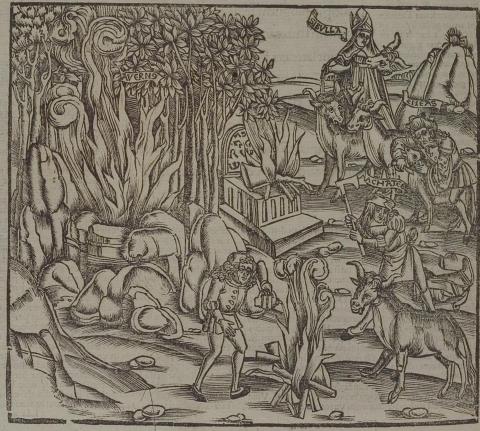Annotations
Aeneas performs sacrifices at the entrance to the underworld at Lake Avernus, which is shown as a circular chasm, shaped a bit like a well, with flame-like vapor pouring out of it (237-42). The Sibyl pours wine on the head of one of two oxen, holding the head of a third; these oxen are a sacrifice to Hecate (243-9). Aeneas slits the throat of a sheep as an offering to Night (249-51); in the text, he sacrifices a barren heifer for Proserpine (251), but in the image, the task is given to Achates, who has shed his armor for the occasion. An altar burns with the leg of a bull for Hades (252-4). Aeneas performs these sacrifices in order to be allowed passage into the underworld. (Katy Purington)
Woodcut illustration from the “Strasbourg Vergil,” edited by Sebastian Brant: Publii Virgilii Maronis Opera cum quinque vulgatis commentariis expolitissimisque figuris atque imaginibus nuper per Sebastianum Brant superadditis (Strasbourg: Johannis Grieninger, 1502), fol. 262v, executed by an anonymous engraver under the direction of Brant.


Sebastian Brant (1458-1521) was a humanist scholar of many competencies. Trained in classics and law at the University of Basel, Brant later lectured in jurisprudence there and practiced law in his native city of Strasbourg. While his satirical poem Das Narrenschiff won him considerable standing as a writer, his role in the transmission of Virgil to the Renaissance was at least as important. In 1502 he and Strasbourg printer Johannes Grüninger produced a major edition of Virgil’s works, along with Donatus’ Life and the commentaries of Servius, Landino, and Calderini, with more than two hundred woodcut illustrations. (Annabel Patterson)